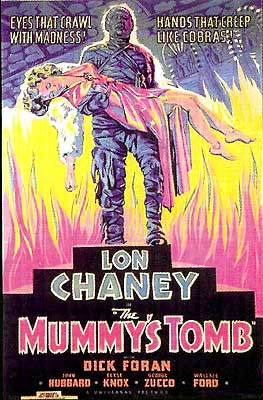 The Mummy’s Tomb (1942) ***
The Mummy’s Tomb (1942) ***
This first sequel to The Mummy’s Hand is probably the strongest of the Universal mummy movies. Like its immediate predecessor, it features a blazingly fast pace and a short running time, but its more serious tone, better monster makeup, and higher quotient of mummy action make it far superior, while its status as a sequel frees it from the burden re-treading so much of the same ground covered by The Mummy back in 1932.
This is also the first of the old Universal monster films to set the action explicitly in modern America. The story begins 30 years after the events of The Mummy’s Hand (which would seem to set that movie in 1912, as certain snippets of dialogue establish beyond question that this film is set in the year that it was made), with Steve Banning (Dick Foran again), now an old man, telling his son John (John Hubbard of One Million B.C.) and future daughter-in-law Isabel (Elyse Knox) the tale of his encounter with the living mummy Kharis (who, when we see him, will be played by Lon Chaney Jr. this time). This device not only allows the filmmakers to remind the pre-television audience what transpired in the last film, but to save a couple of bucks by re-using great amounts of footage from The Mummy’s Hand. But Banning is not the only old man telling tales this night. Across the Atlantic in Egypt, the high priest Andoheb (still George Zucco) is busy telling his successor Mehmet Bey (The Amazing Mr. X’s Turhan Bey— for once we have a Middle-Easterner played by a real Middle-Easterner!) his side of the same story— how 30 years before, outsiders came to violate the tomb of the princess Anankha, and spirited her mummy away after seriously wounding Andoheb and nearly destroying Kharis by fire. As Andoheb passes on his responsibilities as the high priest of Karnack, he also charges Mehmet Bey with the duty to retrieve the stolen princess and wreak the revenge of the gods on those who desecrated her tomb.
So Mehmet Bey secures passage for himself, Kharis’s sarcophagus, and a goodly supply of mummy-reanimating tanna leaves on a freighter bound for Boston, and makes arrangements to work as the caretaker of the cemetery in the sleepy Massachusetts town where Banning has made his home. Scarcely 20 minutes into the movie, Kharis is already shambling around town, looking for Bannings and Banning hangers-on to strangle. First, the mummy kills the Bannings’ groundskeeper, then the next night, Steve Banning himself gets his turn. The uproar surrounding the mysterious killings not only draws the attention of the county sheriff (Cliff Clark), but brings Banning’s old partner Babe Hanson (Wallace Ford, whose character is now thankfully far too old for comic relief shenanigans) rushing in from wherever it was he went after the last movie. (And yes, observant reader, you’re absolutely right. Babe’s last name was Jenson in The Mummy’s Hand!) At first, nobody wants to believe Babe that the murders are the work of a vengeful living mummy, but the authorities stop laughing when the sheriff’s medical examiner identifies the curious gray powder found on the throats of all the victims (which by this time include both Babe and Banning’s matronly older sister) as a combination of a rare North African mold and materials used in the embalming of the ancient Egyptian mummies.
Meanwhile, Mehmet Bey has been spying on his intended victims, and he has taken quite a liking to Isabel. It is for this reason that the evil priest tells Kharis that there has been a change in the plan. Rather than kill the younger Banning, as had originally been intended, the mummy will now restrict his activities for the evening to kidnapping Isabel, so that Mehmet Bey might use her womb to continue the priestly line. Not only that, Mehmet Bey has gotten it into his head that if he gave himself and Isabel an infusion of tanna leaf brew, he and his new American sex-toy would become immortal just like the mummy. This is actually my favorite scene in the whole movie— I love the interaction between Kharis and the priest when the latter tells his undead hit man about his big idea. Even with no dialogue and with three quarters of his face covered with latex appliances, Chaney makes the mummy’s exasperation at his master’s stupidity come through loud and clear. Kharis, after all, has done this before, and the last time he kidnapped a girl so a priest of Karnack could get action, he got set on fire for his trouble. Needless to say, Mehmet Bey’s version of this plan goes over about as well as Andoheb’s had 30 years before.
The Mummy’s Tomb is a strong contender for the title of most entertaining big-studio B-horror movie of the 1940’s. It has all the strengths of The Mummy’s Hand, but in a new setting that does wonders to enliven the basically rehashed story. Its more complex characterization of the mummy himself is another big improvement. And most importantly, in a startling departure from the established practice of its time, there is no fucking comic relief— not even a little bit! Not even from Wallace Ford! The difference this makes in terms of the film’s overall viability is something you just have to see for yourself.
Home Alphabetical Index Chronological Index Contact
